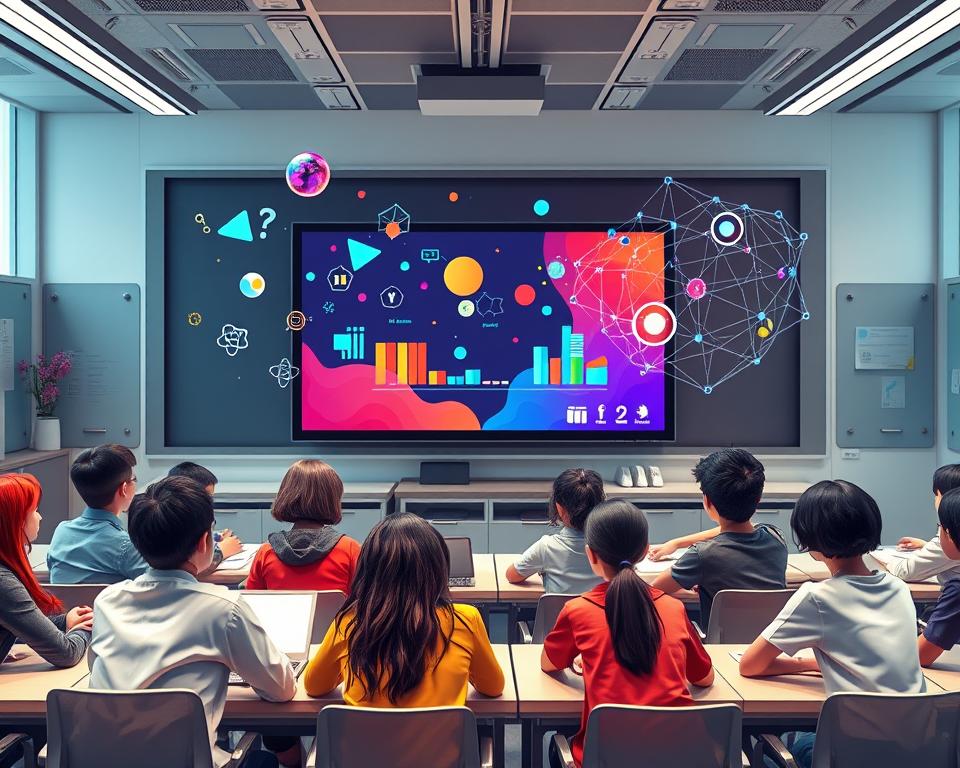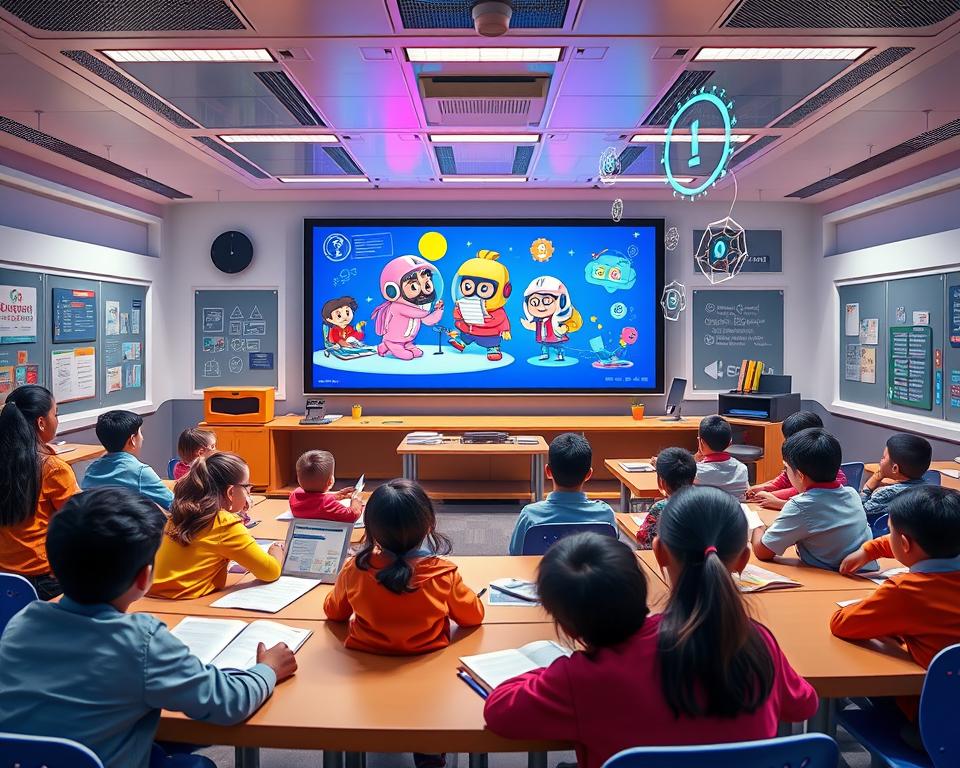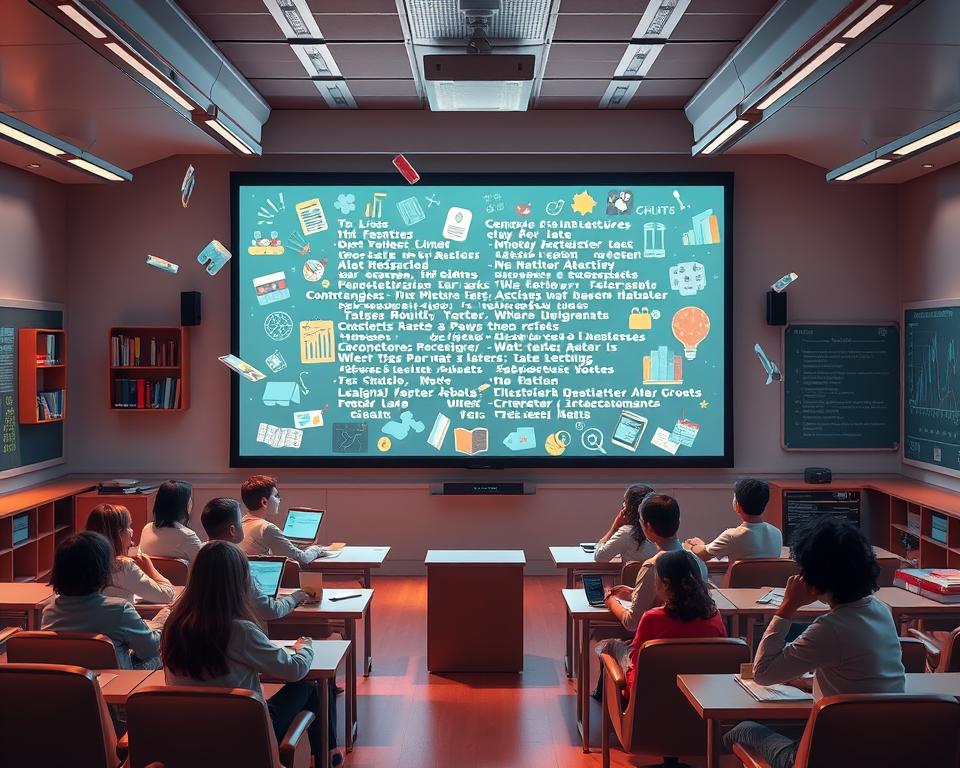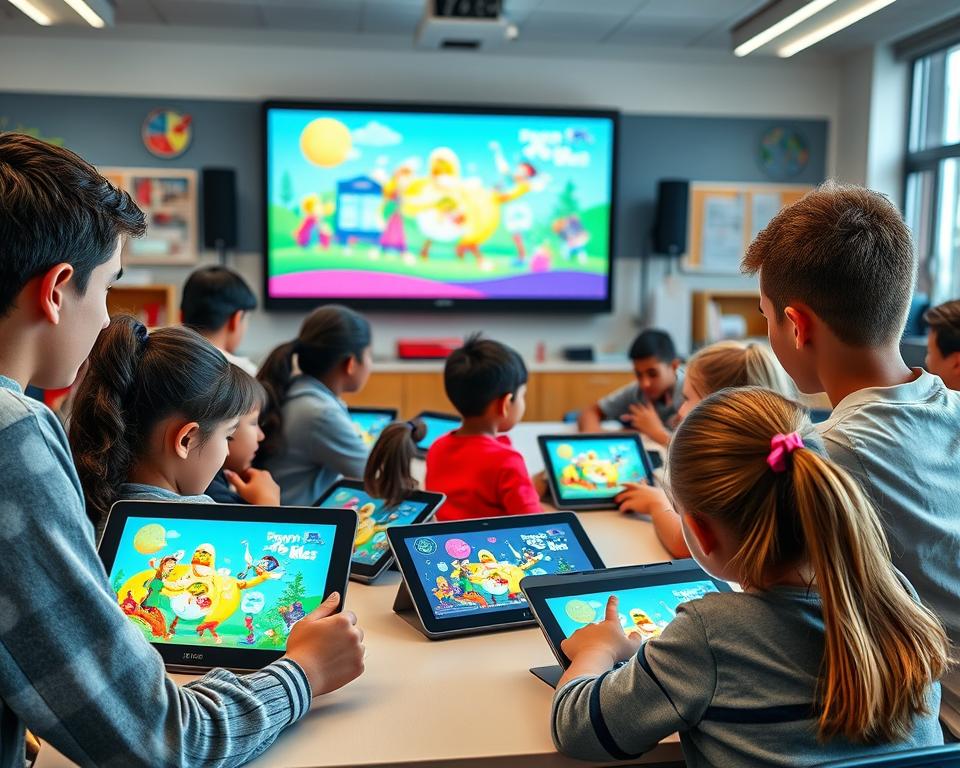Text to video AI for education is changing how we make and use learning content. This new tech lets teachers turn their written. This tech turns text into cool, AI-made videos easily. Teachers just need to type in their lesson plans or written stuff. Then, the system makes great videos with voices, pictures, and more.stuff into fun, video content that grabs students’ attention. It makes learning more fun and effective.

The text to video AI also has a huge media library with over 10 million resources. This includes videos, images, GIFs, and music. It helps teachers add cool visuals to their videos, making learning even better.
The text to video AI is easy to use, even for those who aren’t tech-savvy. It has a simple web interface. Teachers can make videos in just four steps: type in text, pick a voice, add visuals, and download the video. It’s quick and easy.
Key Takeaways
- Turn written educational content into engaging AI-powered videos with just a few clicks.
- Access a vast library of over 1,300+ ultra-realistic voices in 80+ languages and 100+ dialects.
- Leverage a huge media library with over 10 million resources to make videos better.
- Make video creation easy with a simple, web-based platform that doesn’t need tech skills.
- Create learning materials that are fun and inclusive, grabbing students’ interest.
Understanding Text to Video AI for Education: A Modern Learning Revolution
Education is changing fast with text to video AI. This new tech makes sharing knowledge easier and more fun. It helps teachers and schools teach better and make learning more exciting.
The Evolution of Educational Content Creation
Before, turning text into lessons was hard and took a lot of time. But now, AI makes it quick and easy. This change opens up new ways to make learning fun and interactive.
Benefits of AI-Powered Video Learning
- Time-saving and efficient content production
- Consistent quality and professional-grade visuals
- Engaging and immersive learning experiences
- Personalized learning pathways catered to individual needs
- Adaptive learning platforms that mold to learning patterns
- Grading automation that frees educators to focus on instruction
- Virtual assistants ready to answer queries and assist in problem-solving
Impact on Student Engagement
ai video generators and multimedia learning resources have changed the classroom. They make learning fun and interactive. Students stay focused and learn more because they’re involved.
“AI avatars act as virtual pedagogues, making learning more engaging and effective.”
The future of teaching is all about AI. It lets teachers create fun, personal, and interactive lessons. This new way of learning will change how we get knowledge and skills.

How Text to Video AI Transforms Educational Content
Text to video AI has changed how we make and share educational stuff. It lets teachers turn scripts or blog posts into cool videos with great voiceovers. This tech uses AI to pick the right media, clone voices, and work in many languages. It helps make fun training videos and other educational stuff.
This tech makes learning videos more fun and easy to remember. People like watching videos because they’re good for learning. Also, it makes making eLearning stuff easier and faster, without needing to be a pro at design or video editing.
It also makes learning better for people with disabilities. By turning text into videos, it makes learning stuff more accessible. This helps more people learn, including those with visual or hearing problems.
But it’s not just for schools. Businesses use it to make voiceovers in many languages. This helps them reach more people. As it gets better, we’ll see even more cool features, like AI avatars.
It also works well with online learning systems. Teachers can add these AI videos to their courses easily. This makes learning smooth and easy for students.
“AI text-to-video tools offer a transformative solution for educators, empowering them to create engaging, accessible, and scalable educational content with ease.”
More people want to learn through videos, and eLearning is getting bigger. By 2026, it could be worth nearly $50 billion. With our attention span getting shorter, we need learning content that grabs our attention fast.

Essential Features of Educational AI Video Generators
AI video generators have changed how we make educational content. They make it easier to create engaging and effective learning materials. These tools have key features that help in making videos and improve learning for students.
Voice Generation and Language Support
AI video generators can create voices that sound like real people. They work in many languages and dialects. This means teachers can make video lessons for students of all backgrounds.
Visual Content Libraries
Teachers get to use huge libraries of videos, images, GIFs, and music. These libraries help make video lessons look great without needing to make media yourself. This makes learning more fun and interesting.
Customization Options
Personalizing content is important, and AI video generators make it easy. Teachers can change colors, fonts, and layouts. They can even add their own media to make lessons unique.
Using AI video generators helps teachers make content faster and better. It keeps students interested and improves their learning experience.
Step-by-Step Guide to Creating Educational Videos with AI
In today’s world, text to video AI for education has changed how teachers make learning videos. Now, making educational videos is easier and faster thanks to advanced tools. Let’s look at how to make educational videos with AI step by step.
- Input Your Text or Script: Begin by typing the text or script you want to turn into a video. This could be a lesson plan, a lecture outline, or any educational content you want to show in a fun way.
- Choose and Personalize an AI Voice: AI video tools have many voices that sound real. Pick a voice that fits your audience and teaching style. You can also change it to your liking.
- Add Visuals from the Stock Library or Upload Your Own Media: Make your video better with visuals from the tool’s big stock library or your own images, graphics, and videos. This makes your video look great and engaging.
- Preview and Export the Final Video: Check your AI video, fix anything you need, and save it in a format good for school. This easy process lets you make top-notch educational videos quickly, without using hard video editing software.
By using text to video AI for education and video creation tools, teachers can now make interesting, professional videos easily. This saves time and money and makes learning better for students.
“AI-powered video creation has made it easier than ever for educators to bring their content to life and captivate their students.” – John Doe, Education Technology Specialist
Maximizing Visual Learning Through AI-Generated Content
AI has changed how we make educational content. It helps create dynamic presentations and explainer videos. These tools make learning more fun and effective.
Incorporating Interactive Elements
AI content is not just pictures. It includes quizzes and simulations. These features help students learn by doing. It makes learning more fun and helps them remember better.
Designing Engaging Visual Presentations
AI helps make presentations look great. It uses tools like image generation to make slides and animations pop. This makes learning more interesting and helps students understand better.
AI makes learning materials for everyone. It combines text, images, and videos. This way, students learn in a way that works best for them. It helps them understand and remember more.
“Visual content is processed 60,000 times faster than text, making it a powerful tool for engaging students and improving retention.”
AI is changing education for the better. It helps create engaging content for students. This way, students can learn and grow in the digital world.
Time and Resource Benefits for Educators
Text to video AI is changing education, giving teachers more time and resources. It makes making videos fast, from hours to minutes. This lets teachers spend more time teaching and less on making videos.
Text to video AI is also affordable. It has many price options, including free ones. This means more schools can use it, helping everyone get better tech for learning.
Using text to video AI saves teachers a lot of time. They can make more videos and spend more time with students. This makes learning better for everyone.
Text to video AI is now key for schools. It helps teachers use their time better, making learning better for students.
Enhancing Student Learning Experience with Video AI
In education, text to video AI is changing how students learn. It lets teachers make learning fun, personal, and easy for everyone. AI turns text into videos that help students understand better and remember more.
Personalized Learning Paths
Text to video AI makes learning fit each student’s needs. It uses AI to change videos based on what each student learns best. This makes learning more fun and helps students do better in school.
Accessibility Features
This tech makes learning open to everyone. It adds captions and supports many languages. This helps all students learn and succeed, no matter their needs.
Multi-language Support
Today, we need learning materials in many languages. Text to video AI makes this easy. It translates content into many languages, helping students from different places learn together.
Text to video AI is changing education for the better. It makes learning personal, accessible, and in many languages. This tech is making schools more fun, fair, and effective for all students. As AI grows, learning will become even more interactive and tailored to each student’s needs.
Best Practices for Educational Video Creation
As video lesson creators and educators use educational technology, it’s key to follow best practices. Creating engaging and effective educational videos requires careful thought. Let’s look at some important tips for making educational videos with text to video AI.
First, write clear and concise scripts that match your learning goals. The text you give to the AI tool will affect the video’s quality. Make sure your scripts are focused, engaging, and meet your students’ needs.
- Choose the right AI voices and visuals that match your content and improve learning.
- Check and improve the AI’s work, doing 20% of the final touches yourself.
- Add interactive parts like quizzes or discussion prompts to keep students involved.
- Make your video lessons engaging by thinking about pacing, looks, and user experience.
By following these tips, you can use text to video AI to make interesting and helpful educational content. This content will grab your students’ attention and help them learn.
“Generative AI models are like prediction tools, making text, images, and code by guessing based on what they’ve learned. Large language models and generative AI are easy for everyone to use. They can really help teachers and students learn more.”
When using text to video AI in your teaching, remember to think about ethics. Make sure to protect sensitive data and watch for any wrong or biased content. By being careful, you can use generative AI to improve teaching and learning without compromising education’s values.
Integration with Learning Management Systems
The way we teach is changing fast. Text to video AI tools are now working with Learning Management Systems (LMS). This makes it easy for teachers to use AI to make videos for class. It makes learning better for students.
Teachers can now add cool, interactive videos to their online classes. This makes learning fun and saves time. It’s a big win for everyone.
Big names like 360Learning, TalentCraft, iSpring Suite Max, ELB Learning, and Schoox are using text to video AI. They help teachers make learning plans that fit each student. It also helps teachers see how students are doing.
This change is making online learning even better. It’s making it easier to make and share content. It’s making learning more fun and effective.
Future Trends in AI-Powered Educational Content
The way we learn is changing fast. Text to video ai for education and other educational technology are making big changes. They promise to make learning better with new tech like natural language processing and visual generation.
Emerging Technologies
Virtual and augmented reality are coming together with text to video ai for education. This will make learning more fun and real. Students will feel like they’re right in the action. Also, voice cloning tech is getting better, making AI talk more like us.
Predicted Developments
- Language translation will get better, helping students from all over learn together.
- AI will make learning materials for each student, making education more personal.
- AI content will work better with school systems, making it easier to share and track.
These changes in text to video ai for education and educational technology will make learning better. It will be more fun, easy to get to, and fit each student’s needs.
Case Studies: Successful Implementation in Education
Text to video AI has changed education in many ways. It has made learning videos, explainer content, and educational materials better. This has made learning more fun and effective for students.
At Georgia Tech, an AI named Jill Watson helped students a lot. She answered 97% of their questions. At Georgia State University, an AI chatbot named Pounce helped 22% more students. It also answered over 200,000 questions in one summer.
These stories show how text to video AI can personalize learning paths, improve accessibility features, and support multi-language learning. It also helps teachers by doing tasks like grading and scheduling. This makes learning better and easier for everyone.
But, using text to video AI in schools is not easy. Schools need to spend a lot on it and train staff. But, the good it does for educational technology is worth it. It’s changing how we learn for the better.
“AI-powered content creation has transformed the way we approach learning, making it more personalized, engaging, and accessible than ever before.”
As more schools use text to video AI, it will change education even more. These stories give teachers and schools ideas to use this technology well. It’s a big step towards better learning for everyone.
Conclusion
Text to video AI for education is a big step forward in teaching tools. It makes creating content easier, keeps students interested, and offers learning in many languages. This new way of making videos could change how we learn and teach.
This AI helps make educational content better and faster. But, it’s key to remember it should work with teachers, not replace them. Together, AI and teachers will shape the future of learning.
As it gets better, text to video AI will be more important for education. It can make learning more personal, fun, and available to everyone. This technology is set to change education and help both teachers and students.
FAQ
What is text to video AI for education?
Text to video AI for education turns text into engaging videos quickly. It has a simple four-step process. First, you input your text. Then, you pick an AI voice. Next, you add visuals. Lastly, you download your video.
What are the key features of educational AI video generators?
Educational AI video generators have advanced voice generation. They support many languages and dialects. They also have vast visual libraries and customization options to fit your brand.
How does the process of creating educational videos with AI work?
Creating educational videos with AI involves four steps. First, you input your text or script. Next, you choose and personalize an AI voice. Then, you add visuals. Lastly, you preview and export your video.
How does text to video AI enhance the student learning experience?
Text to video AI makes learning better by tailoring content to each student. It supports multiple languages and offers accessibility features. This creates a more inclusive and effective learning experience.
What are the best practices for educational video creation with AI?
For effective educational video creation, write clear scripts. Choose the right AI voice and visuals. Make sure the content meets learning goals. Add interactive elements and design for engagement.
How can text to video AI tools be integrated with Learning Management Systems?
Text to video AI tools can be integrated with LMS for a smooth learning experience. This makes it easy to share AI-generated videos within educational platforms.
What are the future trends in AI-powered educational content?
Future trends include better natural language processing and visual generation. There will be more personalization and integration with new tech like VR and AR. Voice cloning and language translation will also improve.
Source Links
- https://fliki.ai/use-cases/education-and-e-learning/educational-video-maker
- https://simplified.com/ai-for-education
- https://www.enlybee.com/revolutionising-learning-with-ai-for-education/
- https://www.cde.ca.gov/ci/pl/aiincalifornia.asp
- https://fliki.ai/blog/text-to-video-ai-tools-for-e-learning
- https://www.colossyan.com/posts/ai-video-generation-in-e-learning
